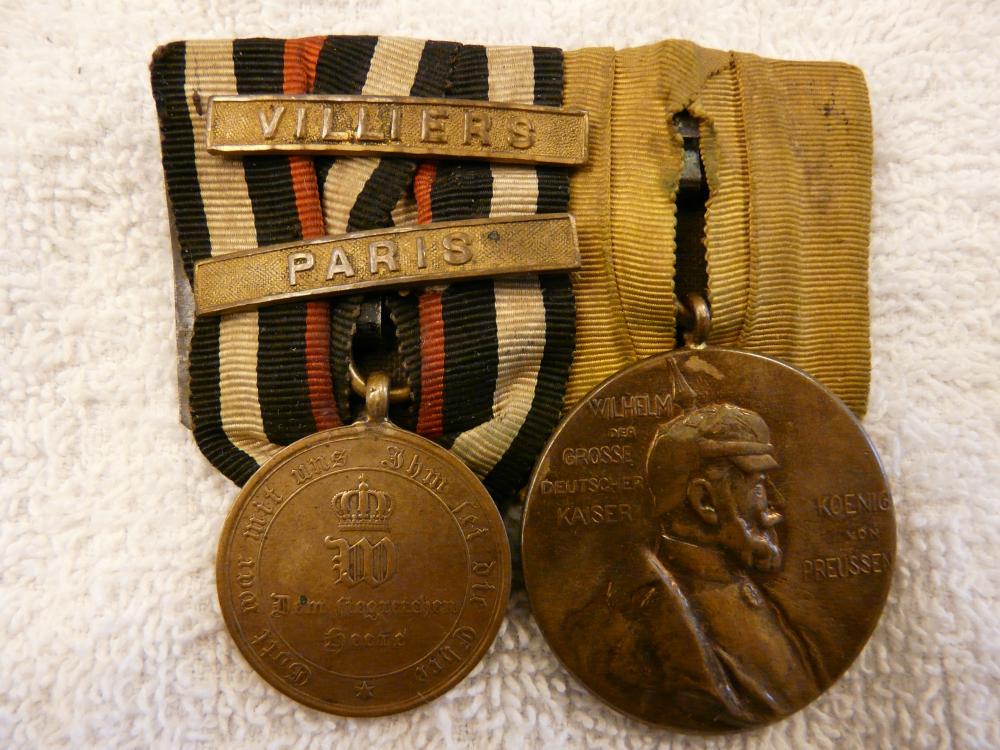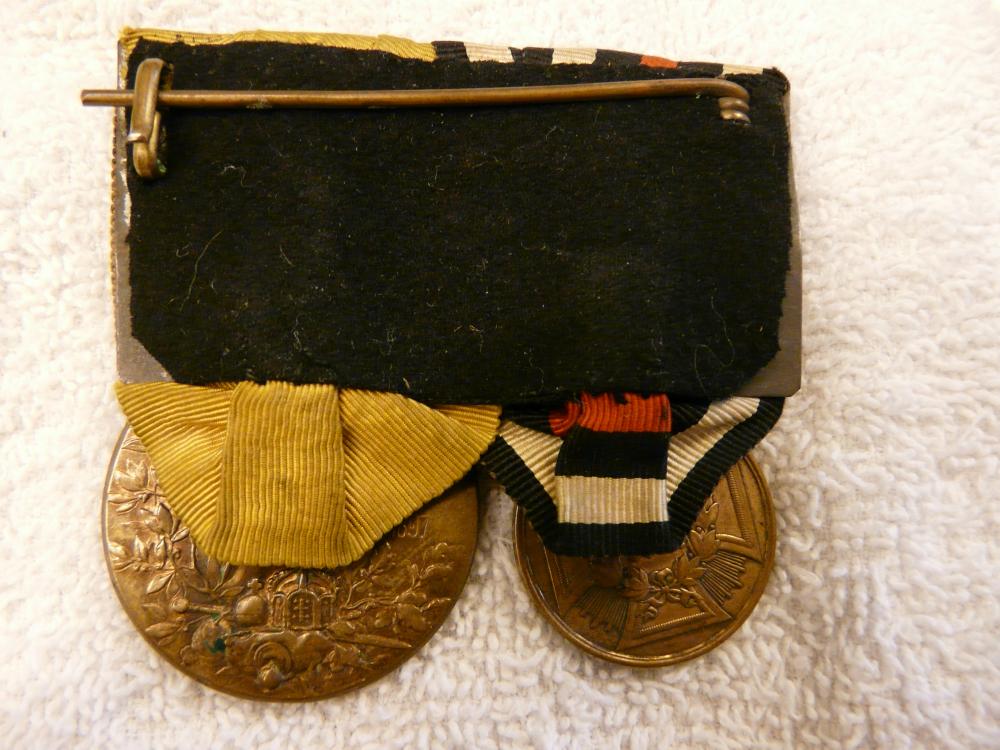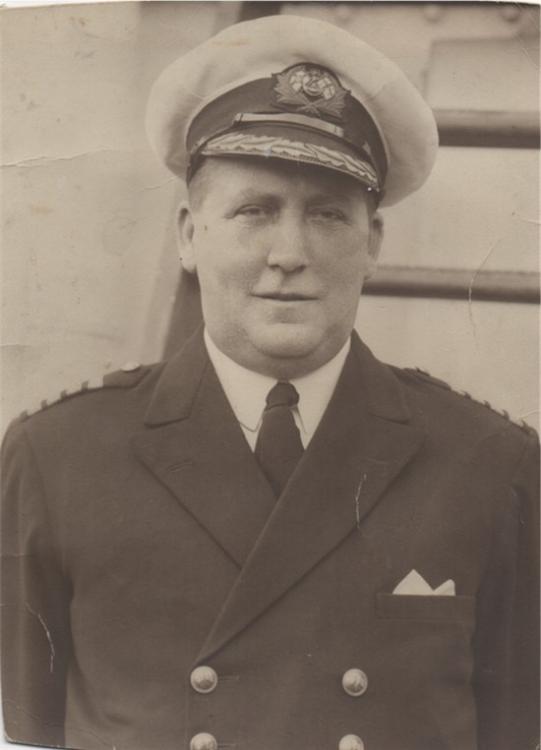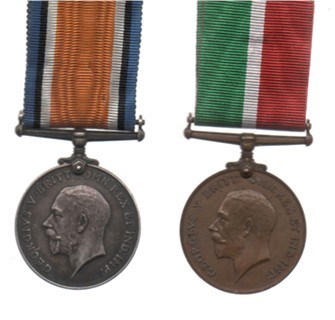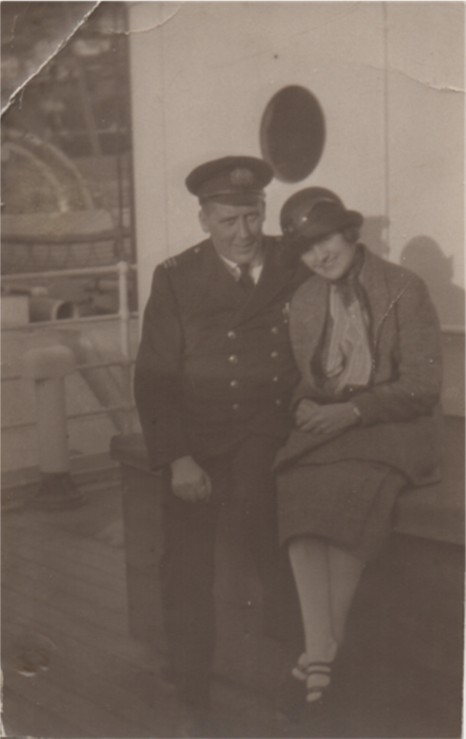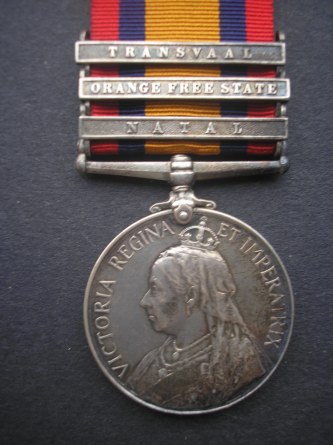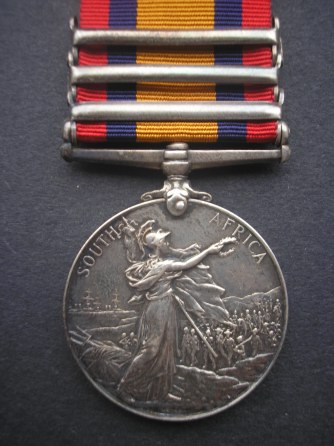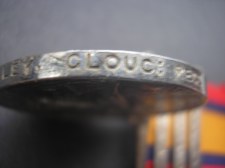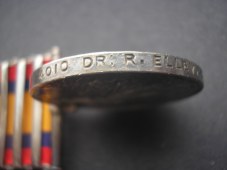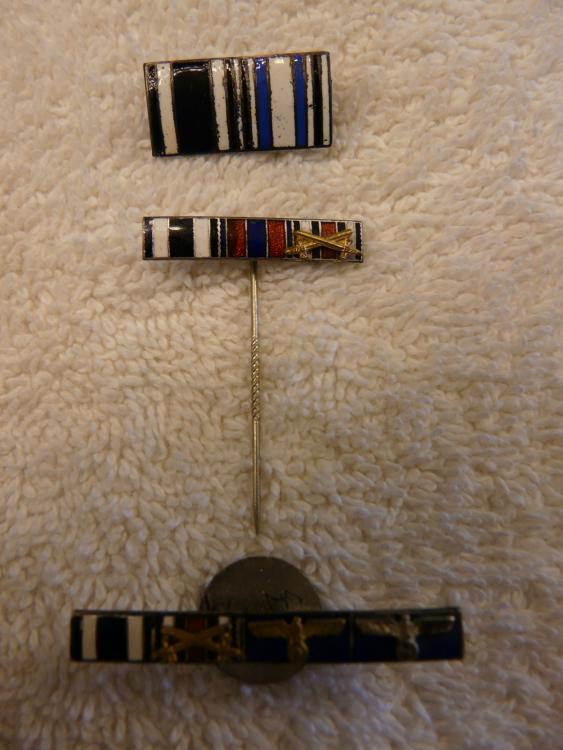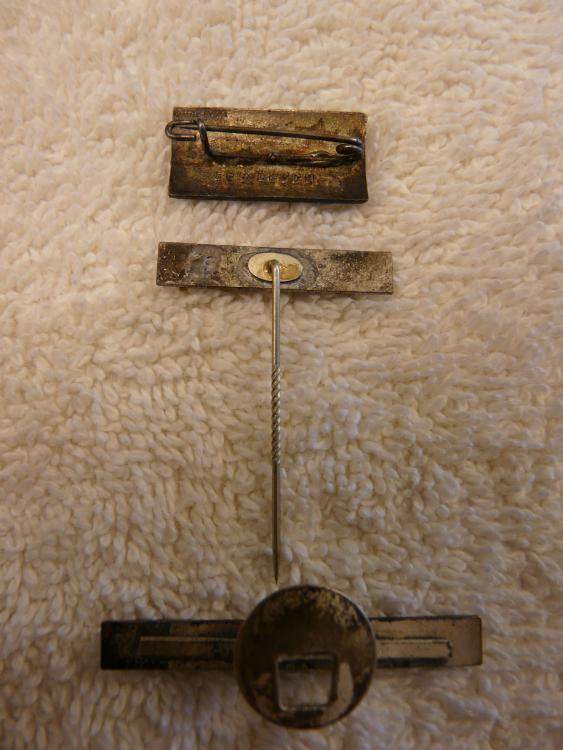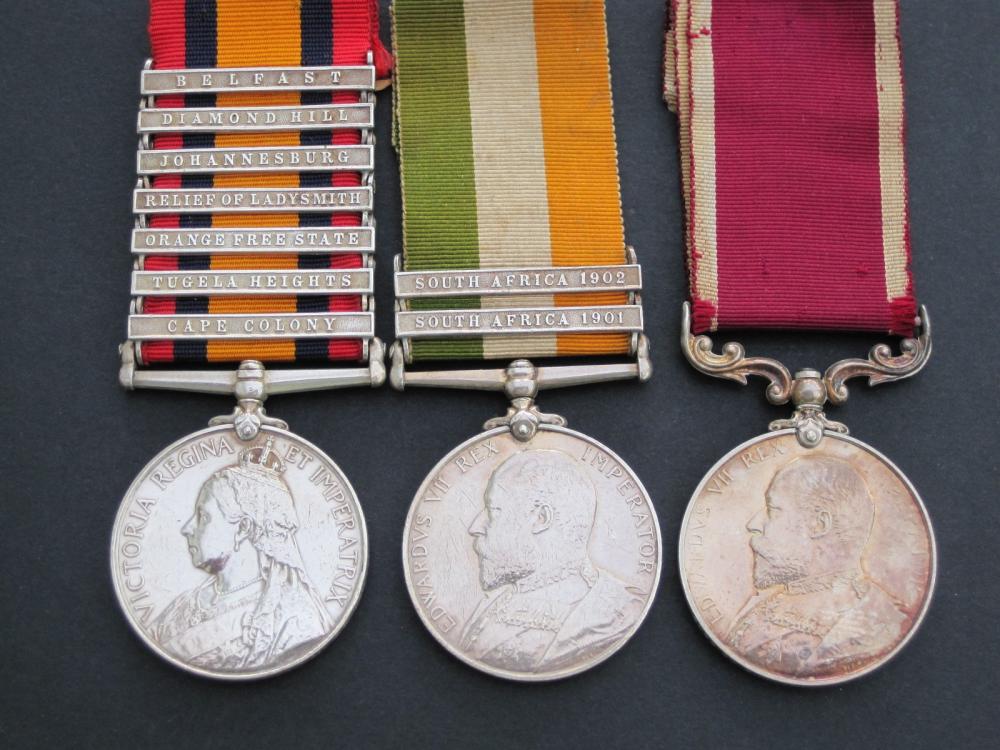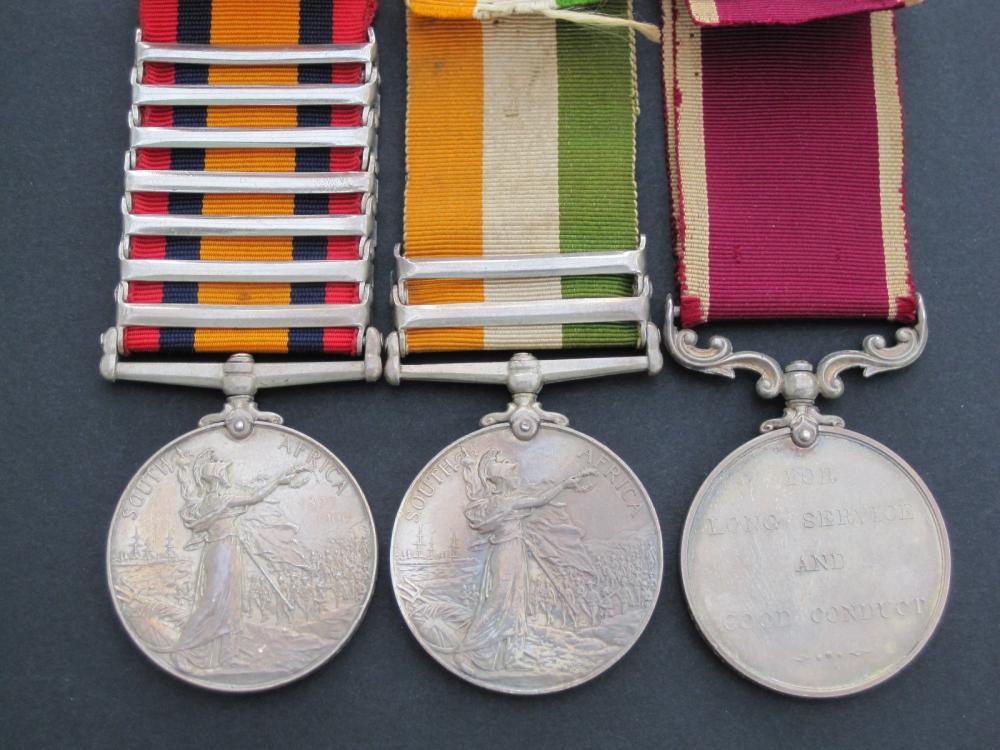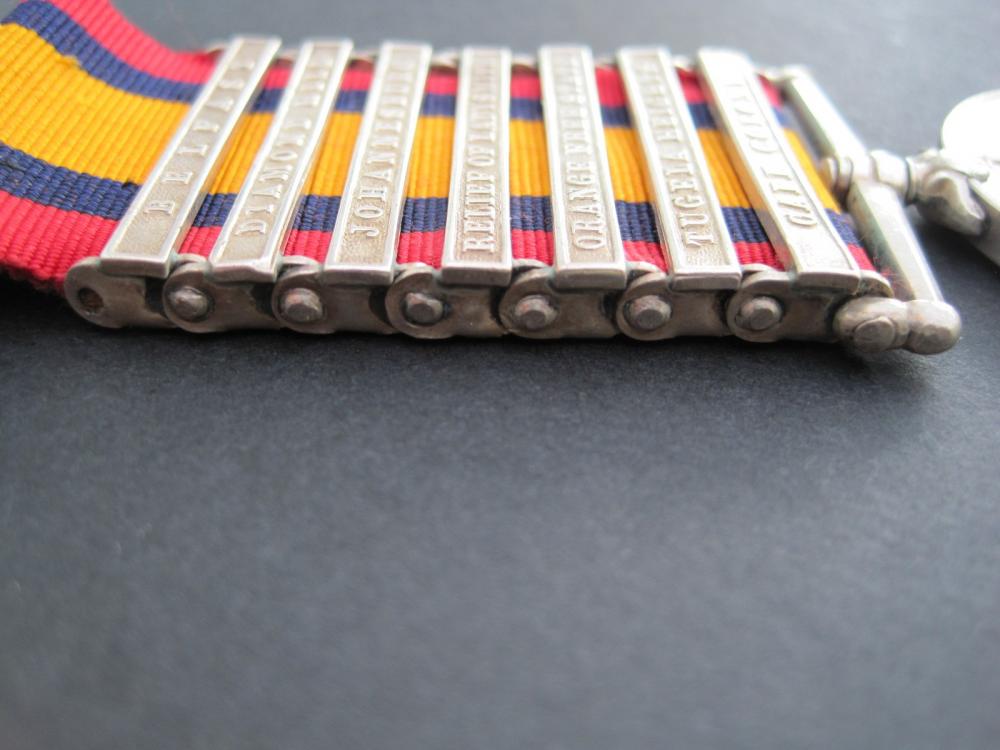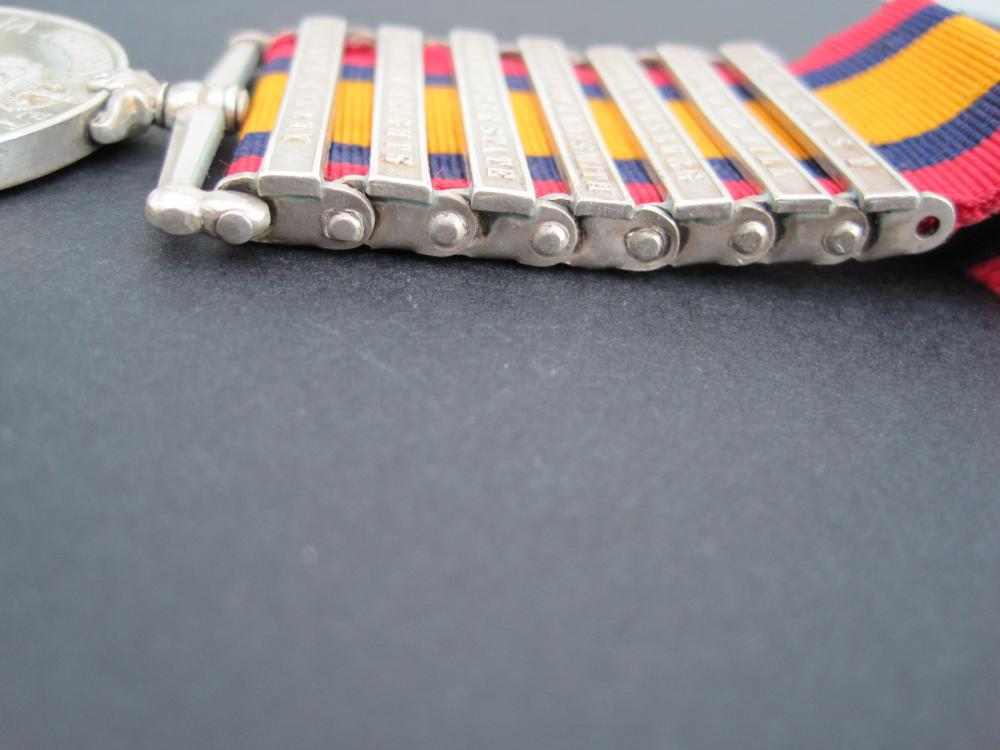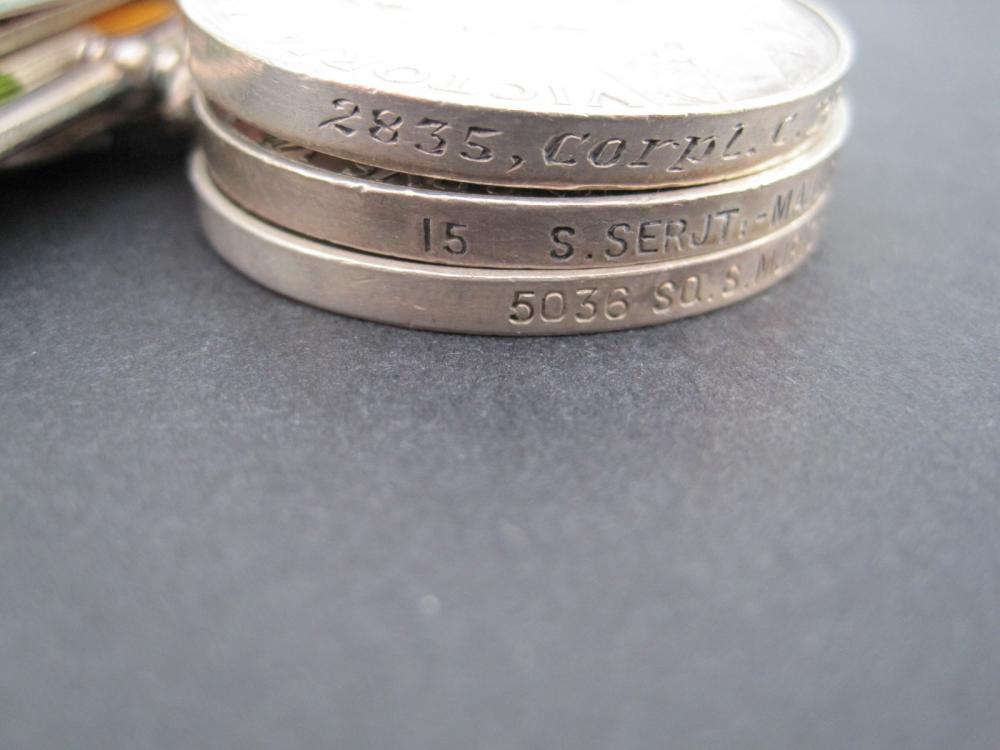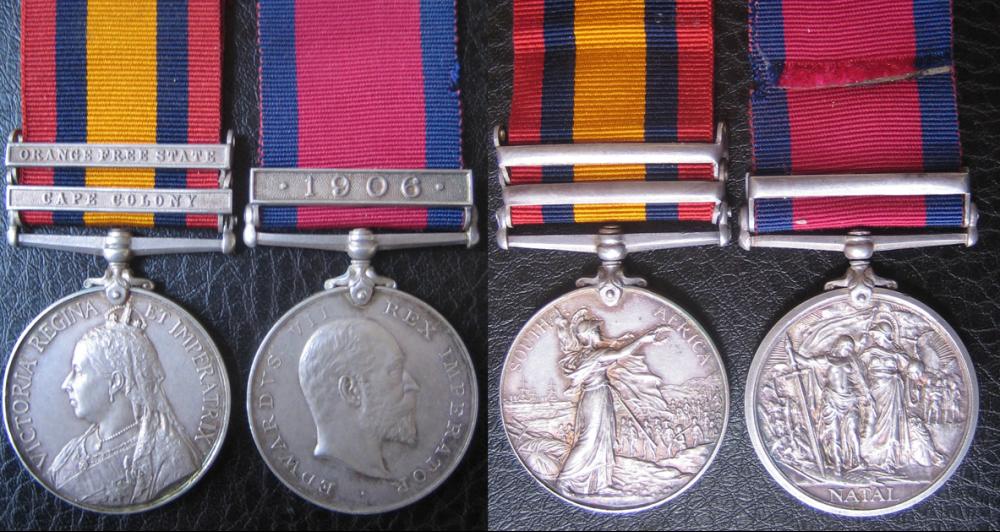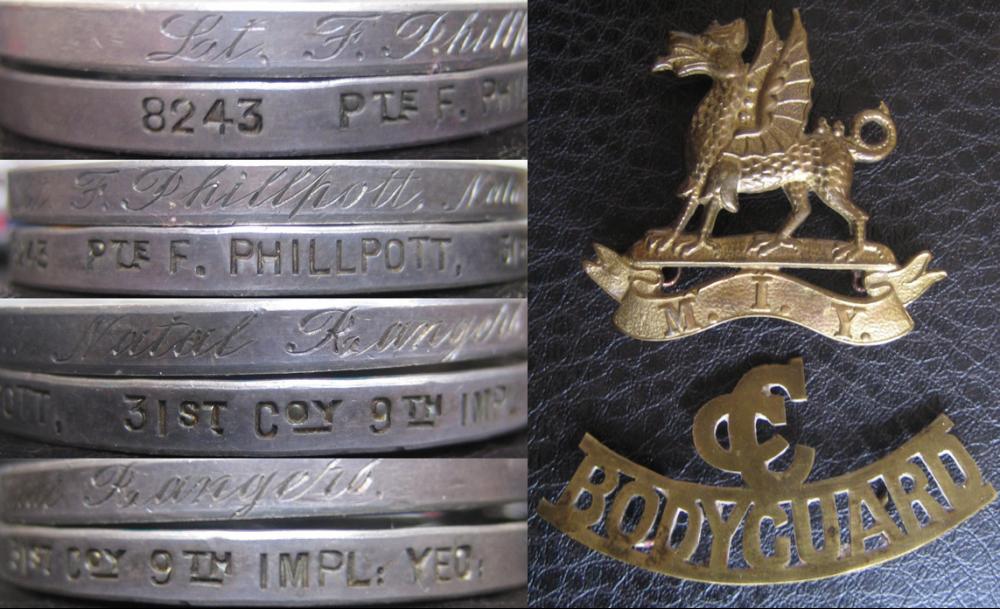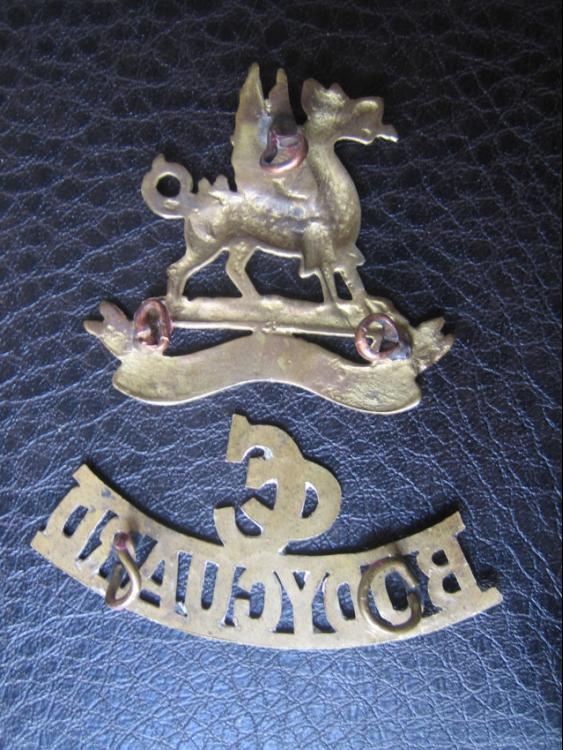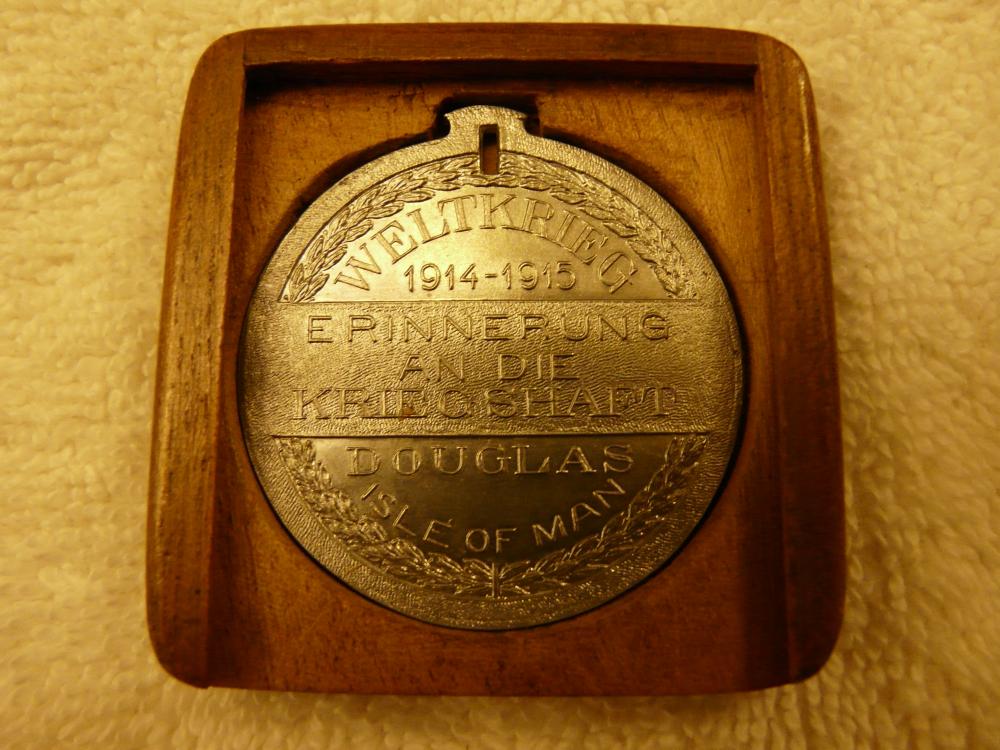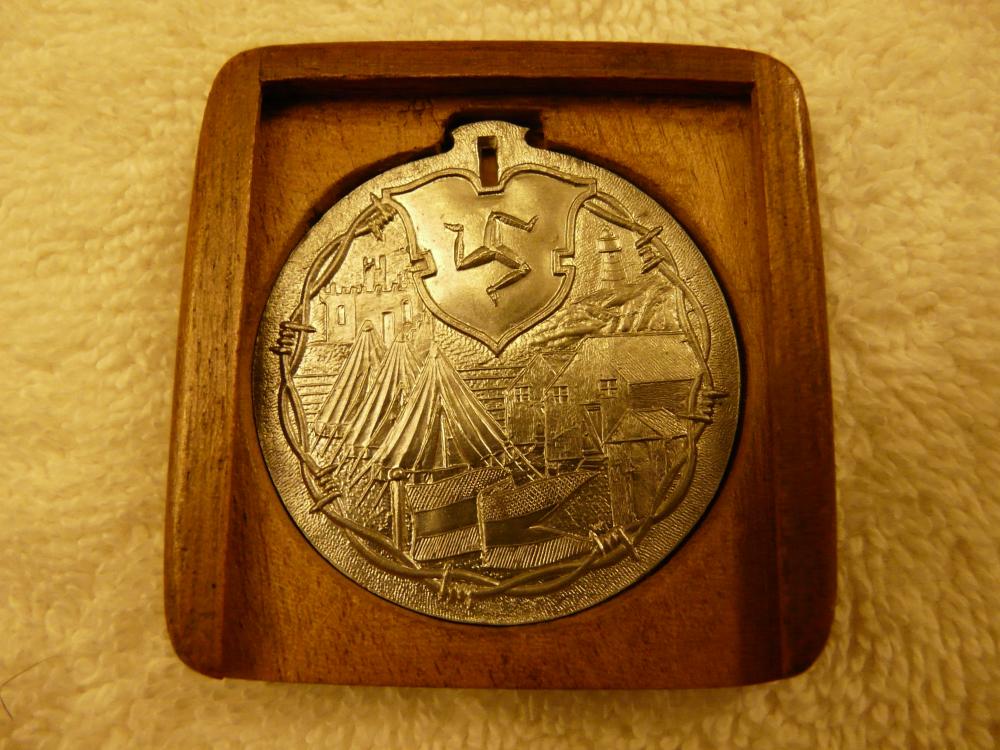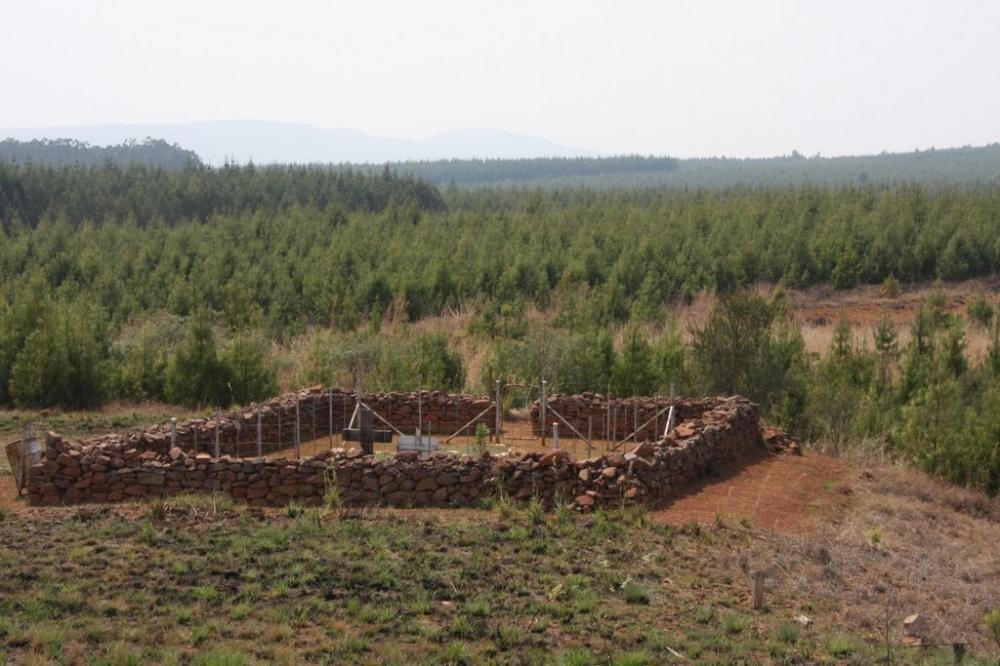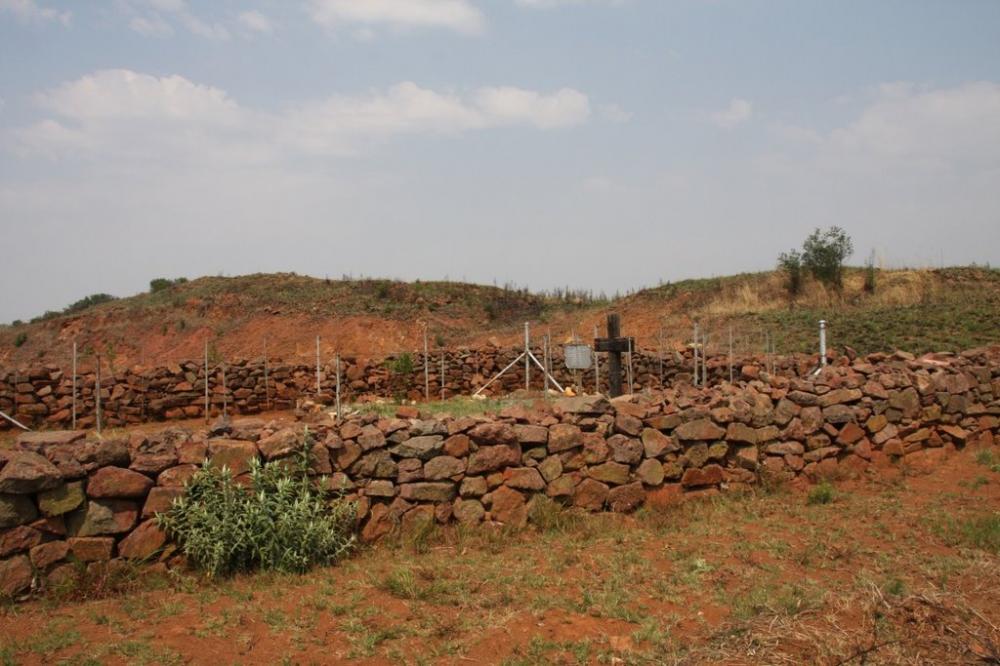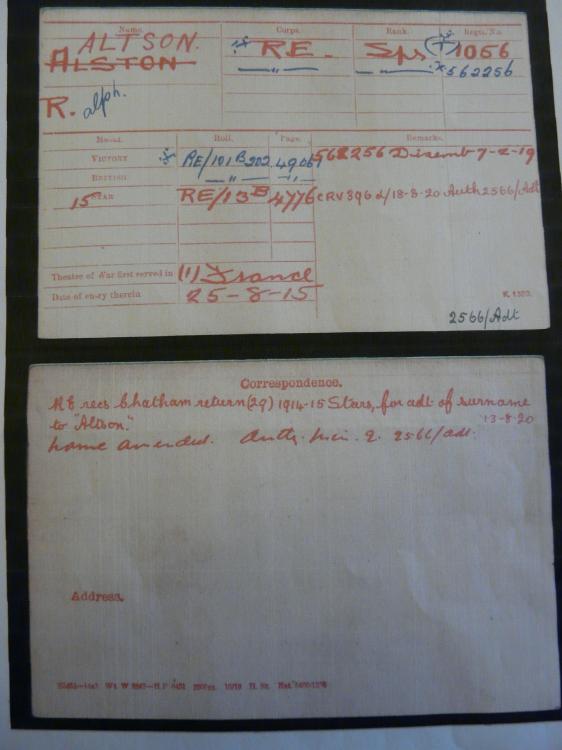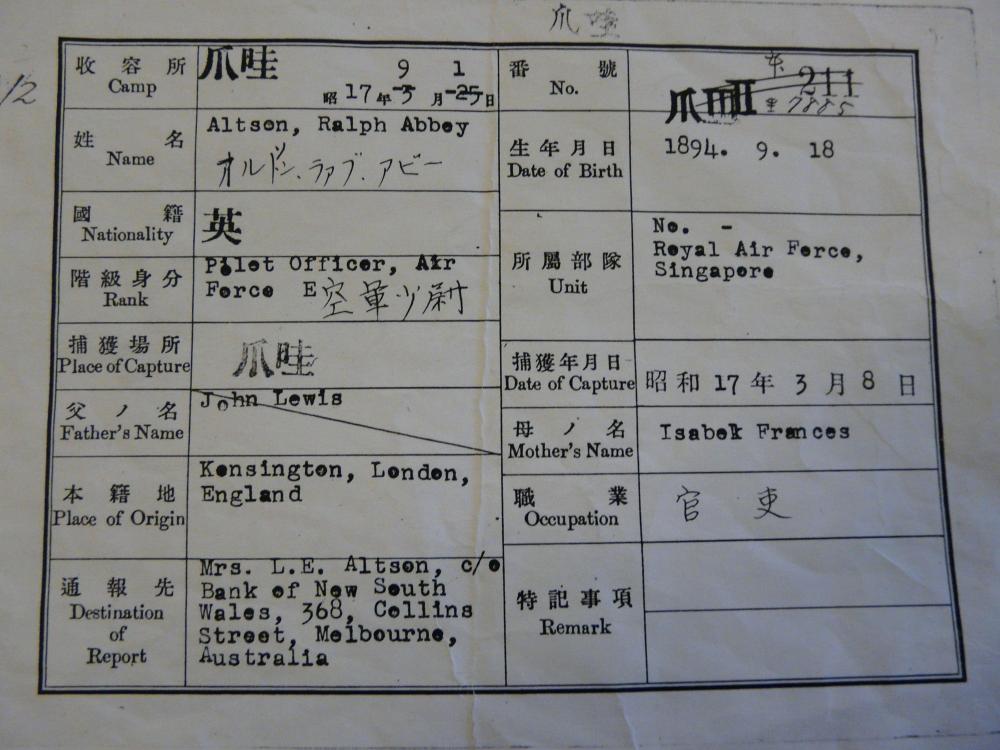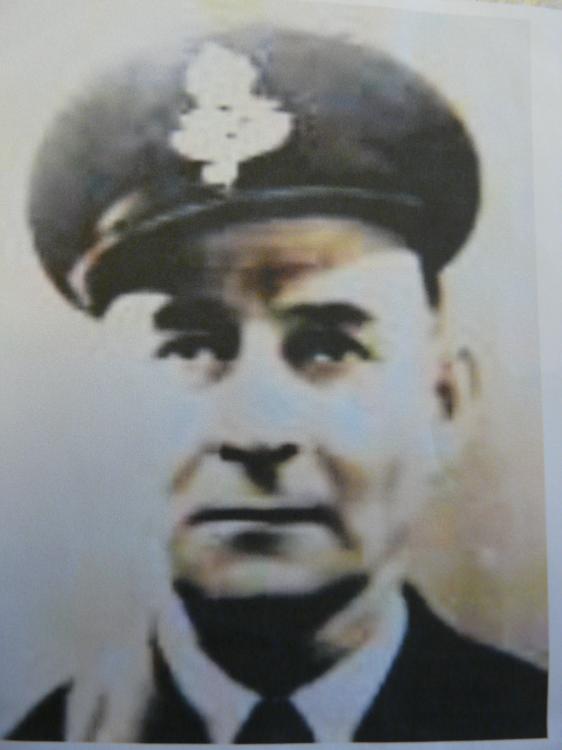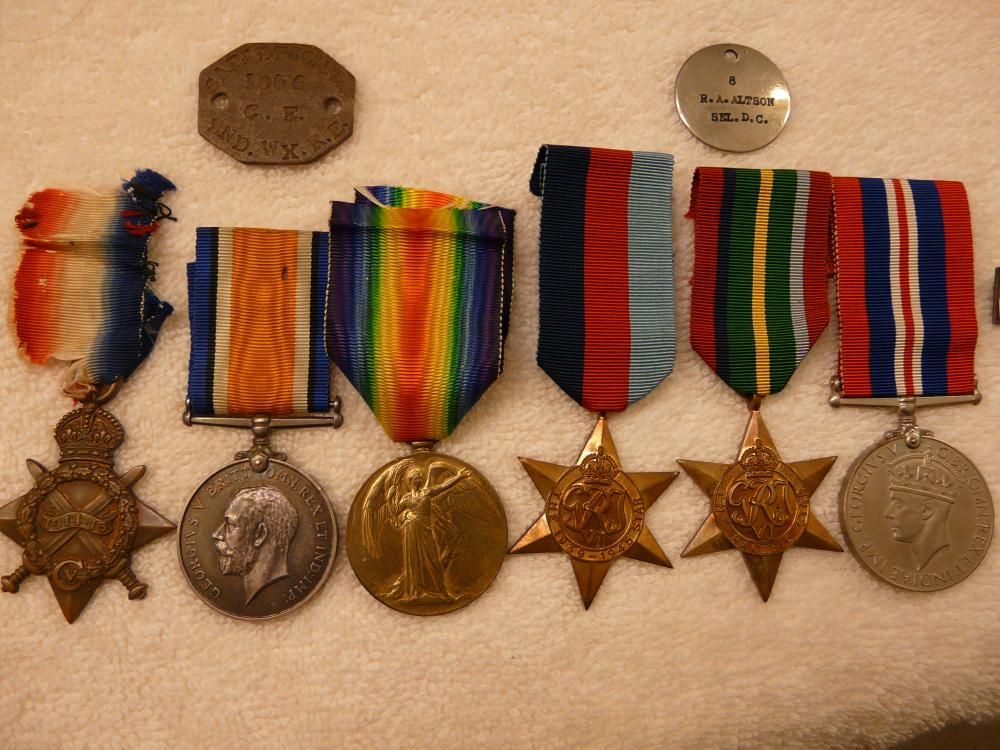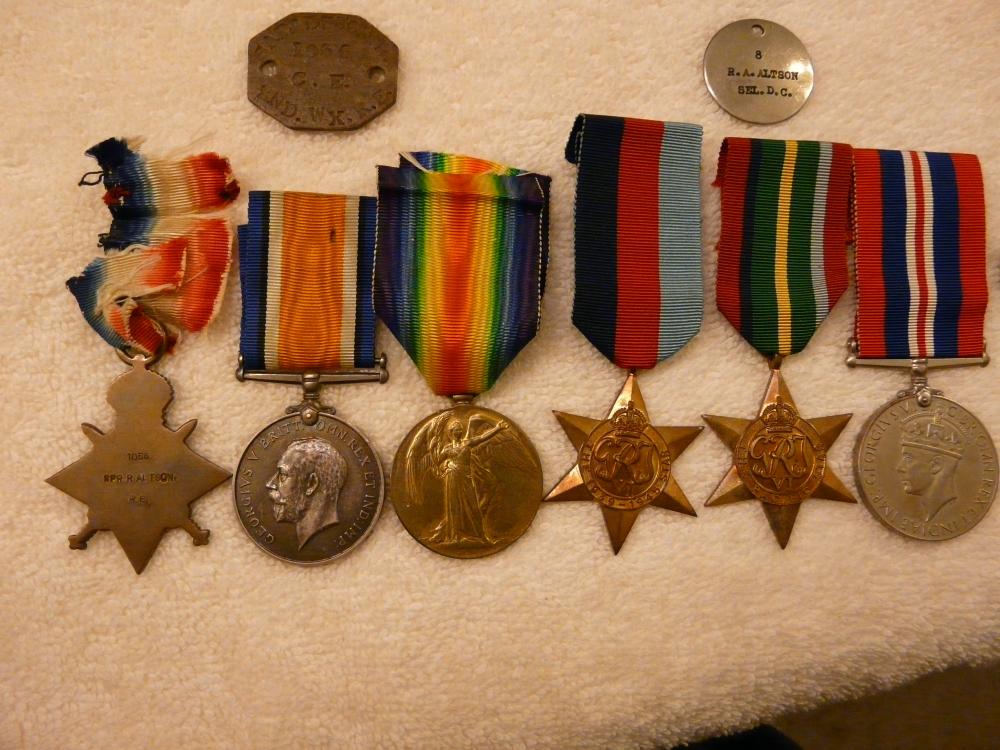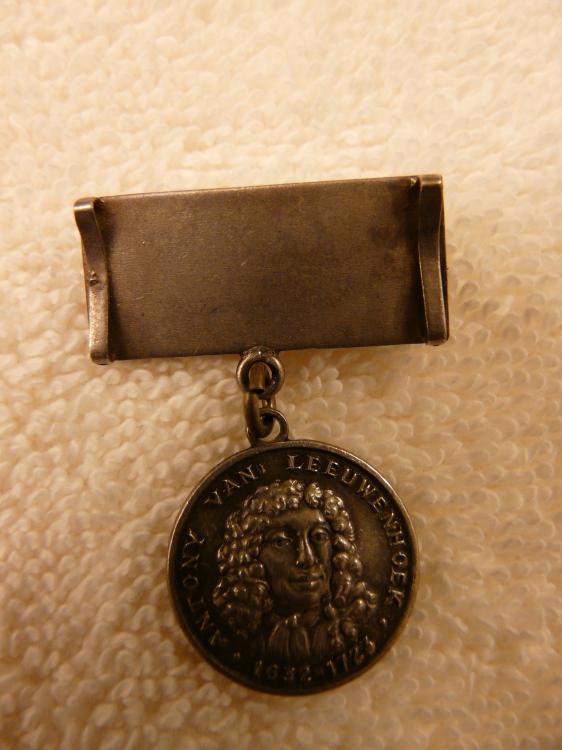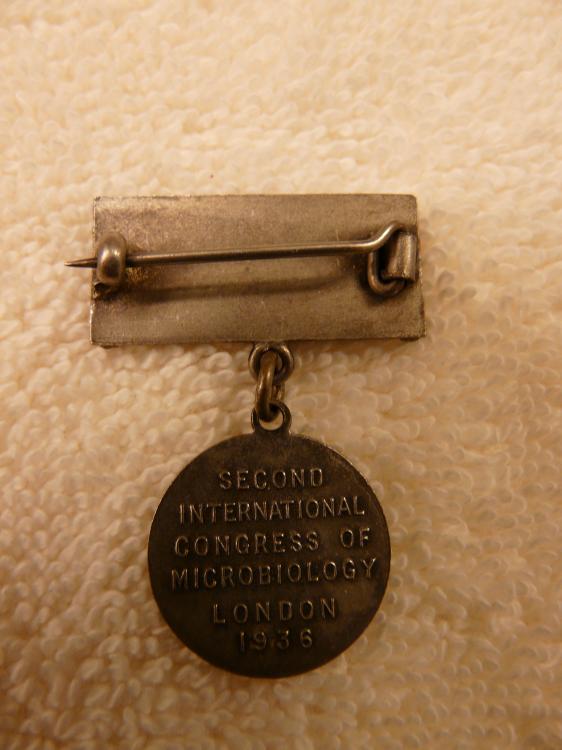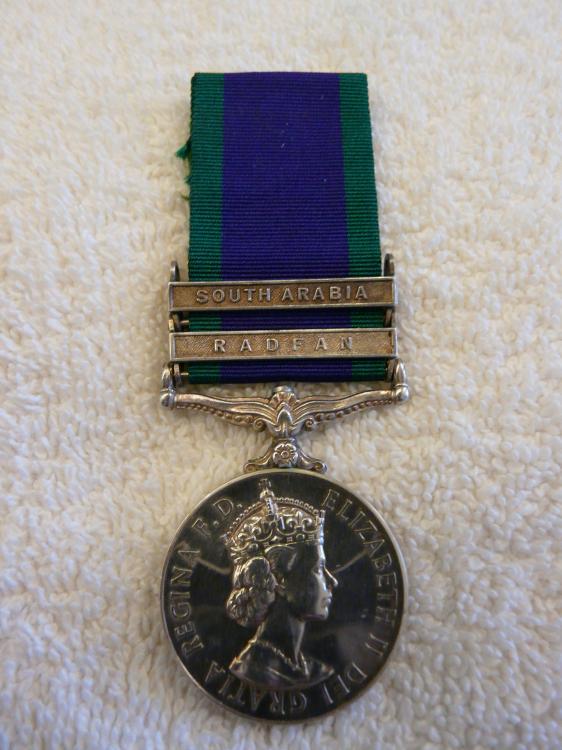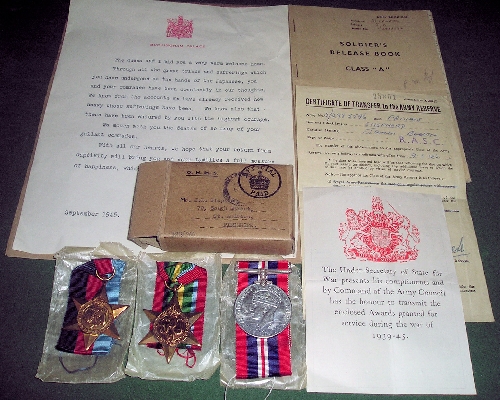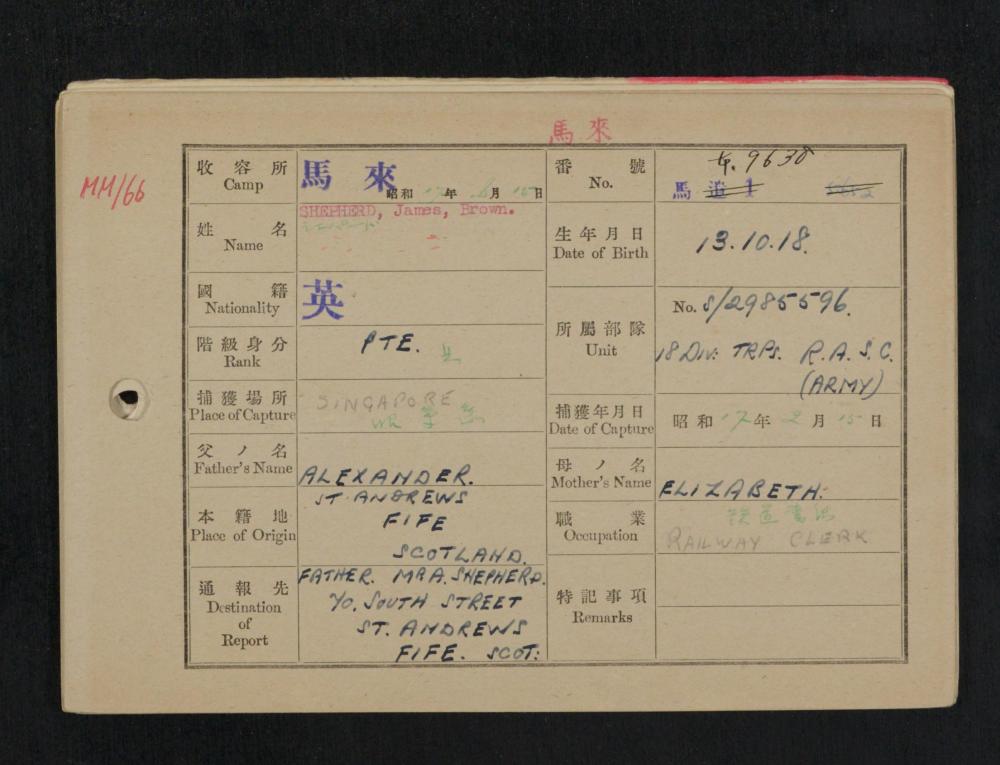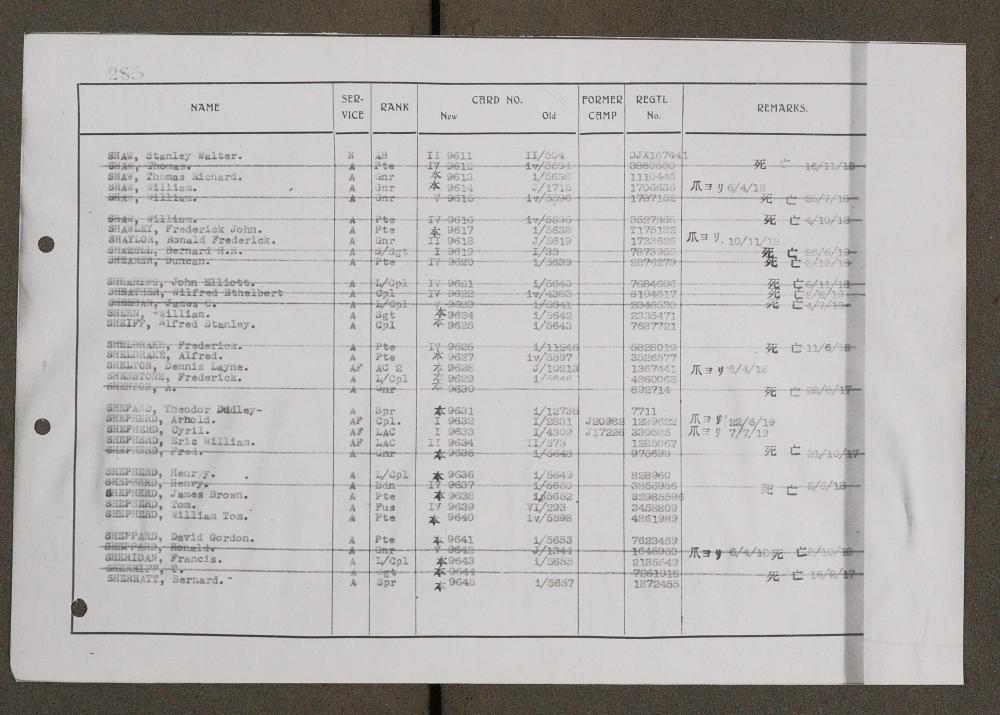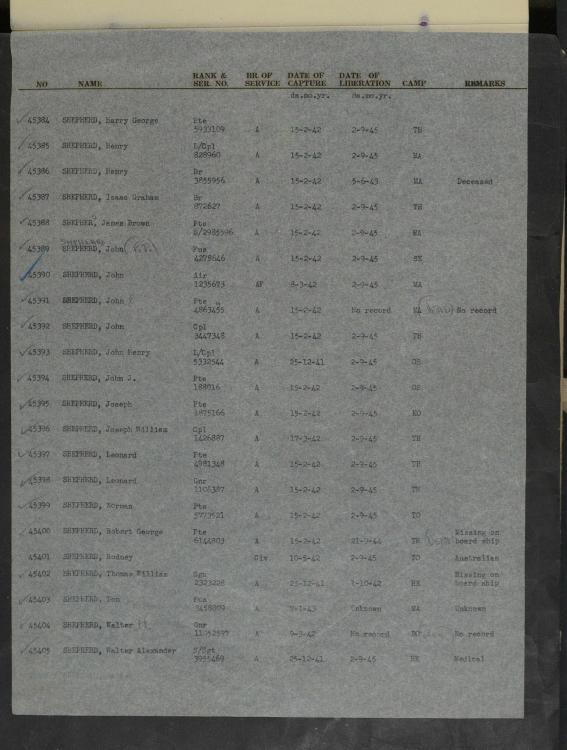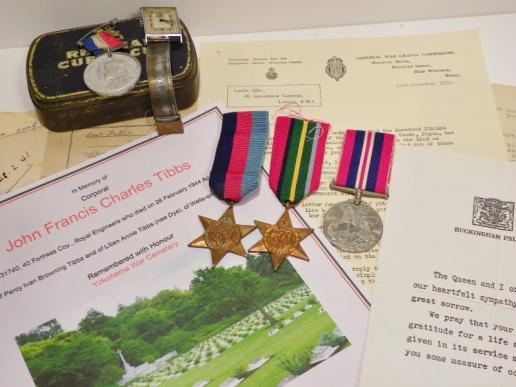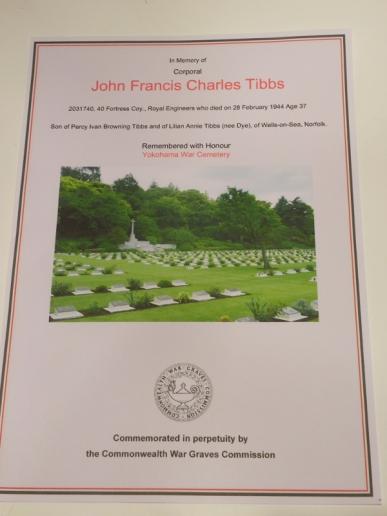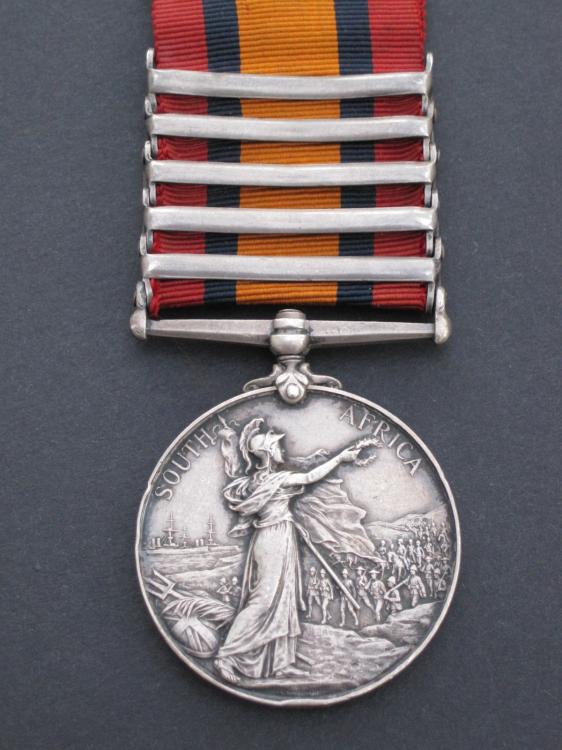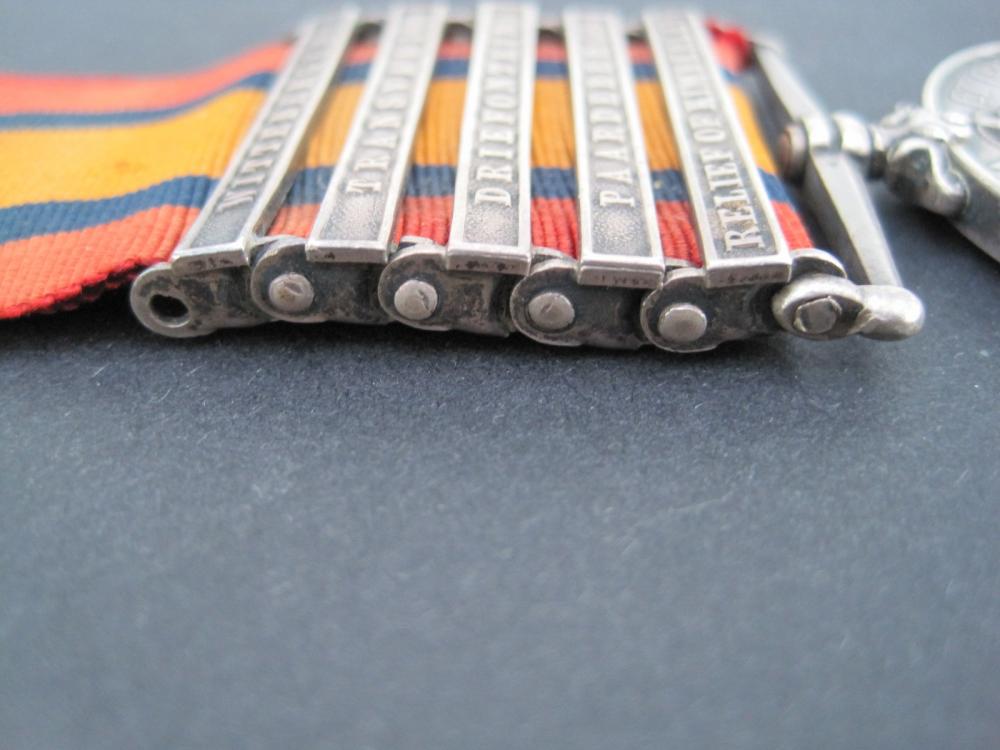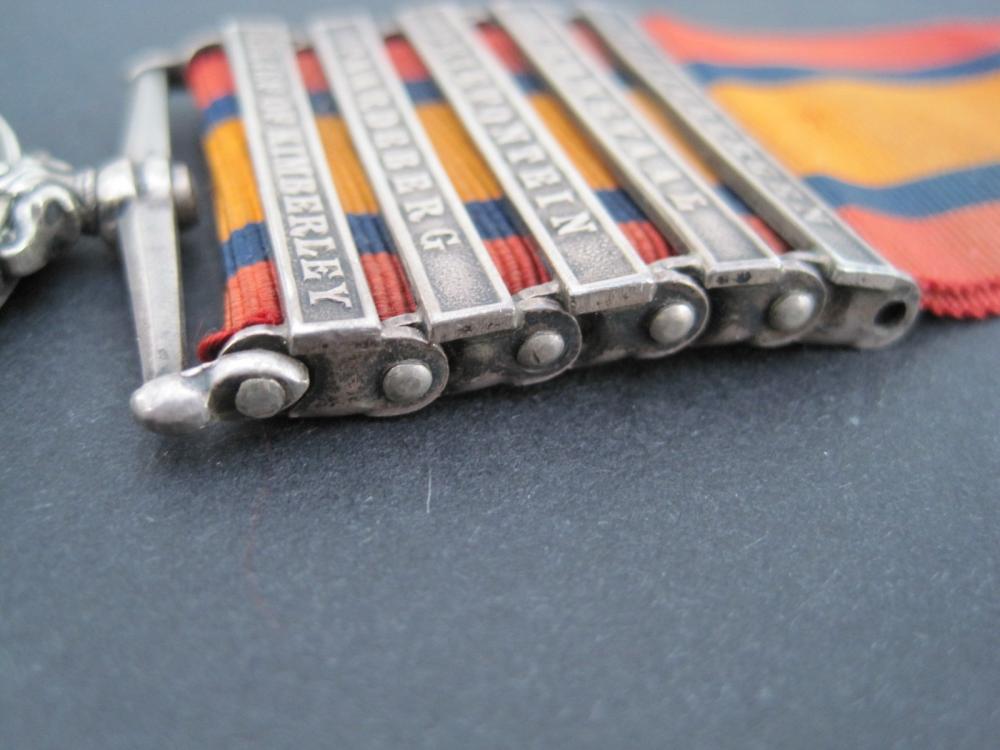-
Posts
1,802 -
Joined
-
Last visited
-
Days Won
10
Content Type
Profiles
Forums
Blogs
Gallery
Events
Store
Everything posted by azyeoman
-
The latest for the collection and all to get another bar: Villiers Most likely to a Wurttemberger as they fought against the French in the largest sortie/battle from beseiged Paris. It took place from 29 November to 3 December and was a German Victory. Although not in the best of shape, this parade mounted pair was once proudly worn by the recipient well over 110 years ago.
-
Thanks Brian and Tony! It's because of you and Brett that I got interested in the PoWs in the 2nd Anglo-Boer War. ; ) Here's the latest acquisition regarding that. Queen's South Africa Medal with clasps: Orange Free State and Cape Colony officially named to: 6561 GNR. W. STONE 68TH BTY R.F.A. King's South Africa Medal with clasps South Africa 1901 and South Africa 1902 officially named to: 6561 GNR: W. STONE R.F.A. William Stone was born in Farnham, Surry and attested to the RFA when he was 15 years and 8 months old. He had no trade. He was 5'7" and was 116 lbs. He had brown hair and grey eyes. He was a protestant and his mother was Mary Elizabeth who lived at 41 East St. Farnham, Surry with his three brothers: Charles, Fred and Walter. He served in S. Africa from 20 Oct. 1899 until 2 December 1902 or for a total of 3 years and 44 days. He deserted on 1 Oct. 1898 and was tried and convicted on 11 Oct. 1899. All prior service was forfeited and he was imprisoned from 20 October 1899 to 14 Novermber 1899 when he returned to duty. He purchesed his discharge on 2 December 1902 for L18. 6561 Gunner William Stone served in the 68th Battery of the Royal Field Artillery in South Africa, seeing service there until 1903. The 68th Battery, RFA arrived in Cape Colony on 17 February 1900. It served in the Orange Free State and later the Transvaal. In 1901 four guns were with Babbington's column in SW Transvaal. On 23 November 1900, Gunner Stone as part of a section of the battery was in the garrison at Dewetsdorp when it surrendered as a result of the attack by De Wet on the town named after his father. The 68th Battery RFA arrived at the Cape on 17th February 1900. Moved north into the Orange River Colony, and afterwards into the Transvaal. Was about Frederickstad and Krugersdorp, August and September 1900, and was frequently engaged. In 1901 four guns were with Babington in a column which did excellent work in the South-West Transvaal. A section was at Dewetsdorp in November 1900 when the disagreeable surrender of the garrison of that town took place. The section lost 1 officer and 8 men wounded. A portion of the battery was with the Oxfordshire Light Infantry in the middle of the Orange River Colony about July 1901, and the section was also in Cape Colony that year. In Lord Kitchener's despatch of 8th March 1901, the first after Dewetsdorp, 4 men were mentioned. Dewetsdorp was a town and railway station in the Orange Free State (Dewetsdorp district; Free State). Having ordered the occupation of Dewetsdorp on 28 March 1900, Field Marshal Lord Roberts ordered its evacuation three days later after the defeat at Sannah's Post. On 2 April the garrison marched out towards Reddersburg, but they were intercepted near that town by commandos led by Chief-Cmdt C.R. de Wet who forced the surrender of the column. The 3rd Field Force under Maj-Gen J.D.P. French forced the Boers to evacuate Dewetsdorp on 25 April and it was occupied by the 8th division under Lt-Gen Sir H.M.L. Rundle. By November the town had been entrenched and was garrisoned by men from the 2nd The Gloucestershire regiment, the 1st The Highland Light Infantry, mounted infantry and two guns of the 68th battery Royal Field Artillery, all under the command of Maj W.G. Massy, Royal Field Artillery. On 19 November Dewetsdorp was invested by burghers under the command of Chief-Cmdt C.R. de Wet with Asst Veg-Gen P.R. Botha and Cmdts H.W. Lategan and P.W. de Vos. After apparently disappearing, the burghers seized a piquet on Lonely Kop* on the morning of 21 November and from the high ground began to shell the town. More outlying positions were driven in and the firing continued. On the night of 22 November, the garrison was driven back to its main position with its water supply cut off. On the following afternoon Massey was forced to surrender. British losses were 14 killed and 75 wounded, the remainder being taken prisoner. The Boers lost seven killed and 14 wounded. For acts of gallantry on 22 and 23 November, Pte C. Kennedy, 2nd The Highland Light Infantry, was awarded the Victoria Cross. For the Boers, Field Cornet W.J. Wessels of the Harrismith commando distinguished himself and was elected its commandant shortly afterwards. HMG II pp.302, 303 and 306-308 (map no.34), III pp.490-493 (map no.38); IV p.703; Times IV pp.67-71 (map of the Orange Free State in front pocket), IV pp.28-33 and 86 (map facing p.32); Wilson II pp.571-572, III pp.219222 (map on p.218); De Wet pp.95 and 220-226. A Gazetteer of the Second Anglo-Boer War 1899-1902. HM & MGM Jones (Military Press, Milton Keynes 1999)
-
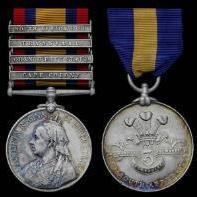
My Prisoner of War Collection
azyeoman replied to POWCollector's topic in Great Britain: Orders, Gallantry, Campaign Medals
Nice one Rob; having the papers makes all the difference. :-) -
The latest acquisition is a rare one. It's to a Captain in the Merchant Navy who was captured, had his ship sunk and then escaped. A simple pair consisting of a BWM and Mercantile Marine, but with an exciting story. B.W.M. & Mercantile Marine (Hubert J. Wilde). With several original items including a fine large photograph of him in uniform and a smaller photograph of him and his wife; two aerogrammes and one handwritten letter to his son during W.W.2. when the recipient was with the New Zealand Shipping Company; and a large letter written whilst Master of the S.S. 'Middlesex' during a 7,000 mile voyage around the Australian coast in May 1937. With a photocopy of his Merchant Navy medal card - the ribbons were issued on 14/8/19 and the medals on 17/12/23; he lived at 264 Neville Road, Forest Gate, London E., and was a Master Mariner. The card contains a photograph of him. Hubert John Wilde was born in Birmingham on 8/5/82; he was 5'8" tall with brown hair and hazel eyes and he had a tattoo of a Japanese girl on his right arm. His next of kin was his wife Jeannie. Newspaper reports describ his experiences in August 1914 while Chief on the S.S. 'Kaipara' (New Zealand Shipping Co.). The vessel had sailed from New Zealand and when it reached Montevideo the crew learned of the outbreak of war. A message was received telling the crew to avoid normal trade routes and reduce lights to a minimum. However on 16/8/14 the 'Kaipara' encountered the German raider 'Kaiser Wilhelm der Grosse'; the Germans boarded her, took the crew prisoner and sent them to the raider before the 'Kaipara' was sunk by gunfire. The prisoners were treated with courtesy by the German crew. Some days later the German raider made a rendezvous off Spanish Sahara with colliers and while coaling she was surprised by the appearance of H.M.S. 'Highflyer'. The latter opened fire and, realising they were outgunned, the Germans told their prisoners to transfer to the collier 'Arucas'; the latter was made fast to the German raider but as the shells from the 'Highflyer' hit the 'Kaiser Wilhelm' and landed in the surrounding sea, Wilde organised the merchant seamen who coolly cast off from the raider. Wilde took the wheel of the collier and took it full steam ahead out of the danger zone; he had got it eleven miles away when the German raider was finally sunk. The 'Arucas' reached Las Palmas safely and Wilde and his crew then took passage on another ship to London.
-

My Prisoner of War Collection
azyeoman replied to POWCollector's topic in Great Britain: Orders, Gallantry, Campaign Medals
Such a very nice group. I love how the caterpiller is on the yellow backing; very nice. Thank you for posting this! All the best, John -

My Prisoner of War Collection
azyeoman replied to POWCollector's topic in Great Britain: Orders, Gallantry, Campaign Medals
What a great acquisition! Your write up is terrific and the story needed to be told and what Jenkins did kept alive. Thank you and I look forward to reading your next one! Thanks very much Robb! -

My Prisoner of War Collection
azyeoman replied to POWCollector's topic in Great Britain: Orders, Gallantry, Campaign Medals
What a great pair to start off your Boer War PoW collection. I date say, you'll get addicted to the campaign's there! Thanks for your posts; I truly enjoy reading them! Cheers, John -
Queen's South Africa 1899-1902, 3 clasps: Natal, Orange Free State, Transvaal 4010 DR: R. ELLEY GLOUC: REGT. Drummer R. Elley was taken PRISONER OF WAR, FARQUHAR'S FARM 30.10.1899 & later released. Robert Elley was born in Aldershot, Hants and lived on Newfoundland Rd., Bristol. Attested in the Gloucester Regt. in 1893 and was discharged in 1913 after serving in: Malta, Egypt, India, S. Africa, Ceylon & India again. He then did Home Service from 1904-1913 and re-enlisted for WWI. He served in the 12th Btn. (Bristol's Own) Glouc. Regt. and is entitled to a 1914-15 trio. It’s a nice addition as it’s to a drummer and only eight drummers were casualties in the 1st Btn. The 1st Battalion was commanded by Lt Col Wilford and was stationed at Allahabad in Northern India in the summer of 1899. The 1st Battalion was one of the four sent from India between 16th and 30th September 1899. They were first engaged on 24th October at Rietfontein (see 1st Liverpool Regiment). The action was fought to enable General Yule to reach Ladysmith unmolested. It was not intended to press the attack home, but the Gloucesters got too far forward on unfavourable ground on the left. They lost Colonel Wilford killed, 1 other officer wounded, 7 men killed and 57 wounded. To the battalion the 30th October was a disastrous day (for general account of action see 1st Liverpool). It will be remembered that five and a half companies of the Gloucesters with six companies of the 1st Royal Irish Fusiliers were sent out under Colonel Carleton of the Fusiliers, with Major Adye as staff officer, on the night of the 29th for the purpose of seizing Nicholson's Nek. By the stampeding of the mules that point was never reached, but the hill near which the stampede occurred, Cainguba, was occupied. The reference to the action in Sir George White's despatch does not enter into details, merely stating that the force "strengthened the position somewhat with breastworks, and remained unmolested till daybreak. It was then found that the position was too large for them to adequately occupy, and that only the most pronounced salients could be held". The Boers surrounded the hill, and after several hours' fighting our men's ammunition began to fail. The advanced parties were driven back, the Boers gained the crest, whence they brought a converging fire "to bear from all sides on our men crowded together in the centre, causing much loss. Eventually it was seen that this position was untenable, and our force hoisted a white flag and surrendered about 12.30 pm." 'The Times' historian (vol ii p 237) gives an admirably clear and detailed account of the action, and in some respects it differs from the despatch. The top of the hill is described as like a foot. The heel at the south end was precipitous and easily defended; towards the middle of the sole or tread there was a rise whence it sloped gently, and the approaches on the north, north-west, and north-east easily afforded good cover for attackers. Against the advice of the owner of the farm, who was present, Major Adye, the staff officer, kept most of the troops at the heel and comparatively few at the forepart, where they were needed. At 11.30 E and H companies of the Gloucesters were ordered by Major Humphery to retire on another sangar. This seems to have been a fatal mistake, as during the retirement one of the companies lost half its strength. Colonel Carleton ordered the sangars evacuated to be reoccupied, but this was found impossible. About 12.30 C company got what was understood to be another order to retire, and again in withdrawing lost half their men. Soon after this three officers of the Gloucesters, finding themselves absolutely without men (except dead and wounded) and unable to see any other part of the position, raised a white flag. The Boers stood up and came forward, and after some hesitation Colonel Carleton came to the decision that the whole force was bound by the white flag which had been shown. 'The Times' historian points out that the staff officer "repeatedly sent orders" that the men were not to fire "independent" but only volleys. The value of volley - firing at single Boers darting from one rock to another can be gauged by the least initiated. But we had to learn all these lessons in the field, and had to pay a very high fee to our teachers. The Gloucesters lost 33 men killed, 6 officers and about 75 men wounded. See the account of the mens' imprisonment by H Rummins. Those of the battalion who were not with Carleton fought and suffered in Ladysmith till the siege was raised. On 22nd December they had the misfortune to lose 8 killed and 9 wounded by one shell from a Boer big gun. After the relief the battalion took little active part in the campaign, and between 21 - 24th August 1900 they were sent to Ceylon to guard the Boer prisoners. They embarked on the Dilwara, Mongolian and Bavarian and landed between 5th and 12th Sep 00. On 12th Sep 00, HQ and 6 Companies went to Echelon Barracks, Colombo and 2 Companies went to Mount Lavinia. Here is a great account by an officer in the Gloucesters about being a PoW. By Major H Rummins OBE. I was one of that ill-fated little force sent out from Ladysmith to Nicholson's Nek on the night of the 29th October 1899. and about 5 p.m., on the 30th found ourselves prisoners of war to the Boers. Historians tell you we were disarmed and taken in wagons to Waschbank Station; this may have applied to the Officers, but as to the 850 rank and file it was certainly not so. We marched a considerable distance across the veldt, and eventually halted for the night, and I distinctly remember what a piercingly cold night it was. The following morning we were on the move early and continued the march to Waschbank Station, where we arrived devilishly hungry and thirsty. We there entrained for Pretoria. The Gloucesters numbered one Colour-Sergeant, twelve Sergeants and approximately 350 men. Arriving at Pretoria we were encamped on the Racecourse, while the permanent camp at Waterval was being prepared; during our stay in Pretoria we were treated fairly well as regards food—for instance, on our arrival we were issued with a 1-lb. tin of bully beef, bread and coffee, and I always look back on that meal in spite of my antipathy to bully beef, as one of the best meals I had during my military career (hunger is a good sauce). After about a fortnight in Pretoria we were moved on to Waterval, where long tin sheds had been erected for our reception. The whole surrounded by a network of barbed wire, outside of which our guards were posted. These consisted of very old men and very young boys, the former were very bitter against us and the latter eager to loose off their rifles on the slightest provocation. On cold and wet nights, some of the old sentries used to mount with an umbrella and a small devil containing a charcoal fire and the bolder spirits among us derived a certain amount of amusement by throwing an occasional stone at the fire, but one had to be careful. During our stay in Pretoria, small contingents of various regiments had been brought in, others continued to arrive after we moved to Waterval, so that at the end of a month we began to look quite a sizeable little force. Little did we dream how large this force was to become. At this time our hut consisted of one Colour Sergeant, twelve Sergeants of the Gloucesters, one Colour-Sergeant and four Sergeants of the Suffolks, and three Sergeants of the Devons. I might here remark that one of the Sergeants of the Devons afterwards became a distinguished General. News was very difficult to obtain and that which we did get was very unreliable. The Boers were always winning and the British suffering defeat. One source of information eagerly looked forward to was through the Boer paper Volkstem, this we used to it usually on Sundays, when the parson from Pretoria came to conduct service and left the corner sticking out of his pocket for the detailed one to pinch. The news in this however, was usually dished up for the benefit of the Boers and which we termed all-lies. There was very little money amongst us at first, but as fresh contingents arrived, the wealth of the camp became more enhanced, and of course, gambling was rife—such games as "Crown and Anchor," "House," and "Banker," being the principal games. There were as many others, of course, as to make Epsom Downs on Derby Day look like a Sunday School Outing. Candles were at a premium; we used to get a small issue and these could always be disposed of at sixpence each, considerably more to the wealthy owner of a gambling table in times of shortage. I believe we (the twelve) had about thirty-six bob between us, and I remember playing Nap for this on one occasion for about 30 hours, apart from meals. I forget what happened in the end to the thirty-six bob, but it still remained in the school, which was something. As you may imagine, fights were very numerous, and afforded quite a lot of amusement. It was not so much going to sea a fight, as to which fight you would go to see. Food, of course, was very poor; we lived principally on mealy meal and rice with salt; occasionally we received an issue of bread, and on rare occasions meat. Butter we was not on our menu, but as a substitute we got a very long and broad fat sheep's tail, usually very rancid, but eatable when rendered down. I believe the Boers bred the particular kind of sheep more for the tails than anything else. Peaches in the season were very plentiful. Tobacco, such as it was, could be had in plenty—it was issued in sacks like wheat, and was very short and dry. Each smoker provided himself with a small bag and a pair of wire' tongs, usually carried on the belt; the small bag was replenished as required from the sack, and as there were no matches, the tongs were used for picking a small brand from any fire one came across to light the pipe. As wood was scarce, one did not always welcome strangers poking about for the brightest bit of burning ember, but it was a recognised practice throughout the camp, and the Britisher—always being pally in times of adversity, very few rows occurred in consequence. Concerts were organised and some very good singers were found in the camp. Also we used to dance to the music of a piccolo that one of the prisoners brought in, and to see three or four hundred lusty fellows doing the Lancers, and suchlike, in hobnail boots and a cloud of veldt dust must have made a native war-dance look tame in comparison. Anyhow it helped us to keep fit, which was all to the good. Christmas came, and some kindly disposed people in Pretoria gave a ration of mutton, which was very acceptable. Some messes, however, went short as the Boer Quartermaster did not know our "C" Company gang of champion "lifters." I remember one of these, seeing half-a-bag of mealy outside the stores, going up to the sentry and asking for a lift-up as he had forgotten it when rations were drawn, he got away with it too. The Quartermaster missed it and came in to search the Camp for it—-he had some hopes. One other of these bright lads got a month in prison at Pretoria for lifting the Commandant's pouch belt and pistol from his office. Trials at escape were numerous, usually by burrowing under the wire and coming up outside. One of these had a comic ending. Six Sergeants in one of the huts made their tunnel and on a selected night entered fully determined to depart ; unfortunately (or otherwise) in the party was one "tubby" an Armourer Sergeant who entered third man and got stuck in the middle. The ones in front lost touch and made so much noise trying to find out what had happened that the first man on popping his head above ground, at the outlet, like a rabbit, found two sentries awaiting his appearance. They got the first two, the others managed to withdraw dragging "tubby" with them more dead than alive, and only just in time, as the Boers came into camp to search for the entrance to the tunnel. I must now describe some of the events which occurred after our removal from Waterval. This happened when Lord Roberts with his Army was close to Pretoria. The Camp Commandant ordered the Gloucesters and Irish Fusiliers to fall in for removal to a new camp, and under instructions from our seniors we entrained like a lot of lambs and were actually passing through Pretoria when our shells were bursting on the forts and alongside the railway. It makes me wild, even to this day, to think what fools we were; the strength of the Camp at Waterval at this time was about 4,000. If my memory is not at fault, we were the only two regiments moved; we were taken to a place named Nooitgedacht on the Crocodile River, and turned into a swampy bit of ground, wired in, but with no covering of any sort against the weather. Fortunately, I had been able to scrounge a very large blanket when first camped in Pretoria, and after making a hole in the ground, stretched this across a ridge pole, pegged down the sides and managed to keep fairly dry in spite of some heavy rain. Conditions during this latter part of our confinement were much worse. Food was more scarce. The Boers were being hard pressed, and, I believe, very short themselves. I had one complaint against them in this connection. The Absent Minded Beggar Fond had been started at home, and goods of all description, including a considerable amount of tinned food, had been sent out to be distributed to the troops; a share of this had been sent up for the prisoners of war. This, however, was not issued free, but sold by the Boer Quartermaster to those who had money to pay. After a short time in this swampy hole, many of the men became sick and deaths began to occur. Our medical officer was a black-bearded old Russian who had an ambulance train on the railway close to the Camp. He was a good-hearted old fellow, who hated to see the conditions under which we were living, and threatened to take his ambulance away unless the Boers moved us, or did something to improve things. Whether he carried out his threat, or moved according to plan, the fact remains, he left the week before our release. His medical comforts he distributed among the prisoners; my share being a Lazenby Soup Tablet, I remember a bit of luck coming our way with regard to food. A small contingent of prisoners were brought; in belonging to a crack Yeomanry Regiment; they had plenty of money and practically bought out the Boers' stores. A day or so after, one of our party, on going down to the river for water, saw one of them making a pot of stew with a piece of buck he had bought. He asked; "How much of this beastly curry does one put in, Sergeant ?" The Sergeant looked in the pot and advised, before putting any curry in, more water was required. The trooper took his can to get more water and the Sergeant passed away with the pot of stew. We had a good feed that day. This same Sergeant played a trick on the Boers worth recounting. A family named Emmett were farming in the Transvaal on the outbreak of War; the father fought on the Boer side ; the son elected to throw in his lot with the British. Of course, the Boers were always on the look-out for him, and rumours got around that he had been captured, and was confined in the prisoners of war camp. The guards searched the camp on two or three occasions for him, but as a matter of fact, none of them knew Emmett. On the last search the before-mentioned Sergeant pointed to a man of ours, belonging to "F" Company, winked at one of the guards, and whispered "Emmett." As none of the guards could say whether he was Emmett or not, in spite of his protestations, he was taken out of camp to one of the Boer Depots for identification. The joke, however, was with him, as he returned in about a week, having had some good food, about thirty bob in his pocket and a new rig-out. In recounting his experiences afterwards, he said : " They didn't half ------ well laugh when they saw me." We heard later that Emmett was captured and given 15 years' imprisonment. Another bit of amusement we had, when one of the prisoners smuggled a pair of wire-cutters into camp and cut the wire entanglements two or three times a week. The Commandant was furious and used to parade and count us on each occasion, search us and the dug-outs, but he never got the wire-cutters, or the man who used them. Conditions in camp had been going from bad to worse; we were half starved, mostly in rags, and sickness was rife. You can imagine therefore with what joy we heard the order on the 30th August to fall in for release. Just ten months to the day after our capture. How we cheered the short farewell speech of General Botha, in which he said: "Soldiers of the Queen, you are being released to-day, and I trust when next we meet, we shall not be fighting each other. Good-bye."
-
I know this is an old post, but this is a great group and so nice that it's IDed and you have the paperwork. Tsingtao items are scarce and when confirmed are so very nice. Thanks for sharing.
-
Another recent acquisiton; a Boer War PoW group of three: Queen's South Africa Medal 1899 - 1902 (with ghost dates) Bars: Cape Colony / Tugela Heights / Orange Free State / Relief of Ladysmith / Johannesburg / Diamond Hill / Belfast (2835 CORPL. C. PENTLAND, 14 / HRS.), King's South Africa Medal Bars: South Africa 1901 / South Africa 1902 (15 S.SERJT:- MAJ: G. PENTLAND, 14th HUSSARS), Army Long Service and Good Conduct Medal, EVIIR issue (5036 SQ. S. MJR: G. PENTLAND, 14 / HRS.). Prisoner of War: Name: G Pentland Casualty Type: Prisoner Casualty Date: 5 Oct 1901 Casualty Place: Holfontein Rank: Sergeant Force: South Africa Field Force Regiment: South African Constabulary Battalion: A Division Number: 1981 Remarks: Released QSA & KSA medals and clasps verified to the rolls. His correct initial on the QSA roll has been changed to 'C' and his South African Constabulary service including serial number is confirmed in the remarks column. LSGC medal awarded in 1911. His service record states that George Pentland was born in Perth, Scotland. He enlisted into the 10th Hussars in 1890, transferred to the 14th Hussars in 1897 and went on to complete 21 years and 34 days service. He died in Brighton on 11 January 1945.
-
The latest aquisition is most interesting. Boer War Yeomanry, Natal 1906 officer group and PoW at the gallant stand at Reitz or Fredericksdale on 3 January 1901 QSA, CLASPS CC, OFS.‘8243 PTE F PHILLPOTT OF 31ST COY, 9TH IMPL YEO’, NATAL , CLASP 1906 ‘LT F PHILLPOTT, NATAL RANGERS with the medals are a scarce Montgomery Imperial Yeomanry and Commander in Chief’s Bodyguard Badge Frank Phillpott, a 21 year old clerk, joined the 31st Coy, 9th Imperial Yeomanry (Montgomery Yeomanry) on 8th Jan 1900 and served with them in South Africa from 14th March 1900 – 17th Nov 1900. Joining the Commander in Chief’s Bodyguard on the same day, he served with this unit until 16th May 1901. Phillpott was captured at Reitz or Fredericksdale on 3 January 1901 when General Botha ambushed 120 members of the Bodyguard, killing 18, wounding 33 and capturing most of the rest during a desperate action against far superior Boer Forces. Its not clear how long he was prisoner, but he seems then have gone home but then reenlisting in 119th Company Imperial Yeomanry (Younghusband's Horse) on 11th Dec 1901 and served for a second time in South Africa from 8th Feb 1902 until the end of hostilities, attaining the rank of OR Sergeant. For more information, read the following paper by Laurens and Watt: samilitaryhistory.org/vol143lw.html Post Boer war Phillpott joined the Natal Rangers who he served with during the Zulu Rebellion in 1906. The Natal Rangers served throughout the campaign including the battle of Mome Gorge Entitled to SA 01/02 clasps which were issued separately to the QSA in June 1904. He was not entitled to a KSA.
-

From the trenches to the shadows
azyeoman replied to dante's topic in Great Britain: Orders, Gallantry, Campaign Medals
Wonderful! Keep up the good work and posts. -
King’s South Africa Medal 1901-1902, 2 Clasps: South Africa 1901, South Africa 1902; (5462 CORPL: S. JONES. LIVERPOOL REGT Jones was present during the Boer War in South Africa, and was taken prisoner of war at Helvetia on 29th December 1900 before being released by the Boers during a prisoner exchange. Jones is also entitled to a QSA with clasps; please contact me if you know its location. Part of Buller's force long continued to garrison Lydenburg and the posts between that town and the railway. One of the posts, Helvetia, close to the line, was garrisoned by about 250 men of the Liverpools with a 4-7 naval gun when the place was attacked and captured by a strong force of Boers on 29th December 1900. In his telegraphic despatch Lord Kitchener described Helvetia as a "very strong post", and he seemed to be surprised at its capture. Our losses were 11 men killed, 4 officers and 20 men wounded, and the remainder taken prisoners. No official explanation of the loss of the post has ever been made public, and from some points of view this is a matter of regret, as the incident, left as it is, tarnishes the reputation of a regiment which had done very good work. Very probably a few individuals were responsible for the Boers getting in; and it has been said that in any event there is very good ground for believing that it would be better for the regiment involved, and for the service generally, if the result of the official inquiry in such a case were published. Here is another site that sheds light on the events and according to it, the Kings had been drinking and so didn't account very well for themselves. https://streamsandforests.wordpress.com/tag/battle-of-helvetia/ An excerpt is: "Two hundred and thirty-four men of the Liverpool regiment marched in a long irregular file behind the gun. When the Boers had overrun the fort and the commanding officer was wounded, many of the Liverpools had filled their water bottles from the garrison’s barrels of rum. Some were already too drunk to walk, while others offered swigs to their captors. As the motley procession staggered up a long hill, thunder and lightning made the sky crackle. The air turned solid with rain. The gun team of 18 oxen struggled and slithered in the mud. Knots of unguarded prisoners followed along, not inclined to run off into the sodden veld. During the height of the downpour Schikkerling and a comrade named Malherbe dismounted and sheltered themselves under their blankets. When they rode on again, they passed straggling Tommies, miles behind the others, who inquired brightly if they were “right for the laager [camp].” The two landscape photos are of the monument located on the Helvetia Battlefield. There is info on Jones in JB Hayward & Sons book South African Field Force: http://search.findmypast.co.uk/record?id=gbm%2fbw%2f042459
-
Hi Tony, Other than the LGs of May and June 1942, I don't have any specifics on his WWII medals. They're just the "common" ones given to all. It has always bewildered me how PoWs were given so few medals and so little when they suffered so much. Yes, we all know the rules, but it seems like they should have been recognized; perhaps with something like the US has done, a PoW medal.
-
Here is some more information and photos related to Altson's group. RAF PoWs in the Far East Captured Simultaneously with their attack on Pearl Harbour, Hawaii, on 7th and 8th December 1941, the Japanese landed at Kota Bharu, Malaya, and also crossed the border into Mainland Hong Kong. Hong Kong fell on 25th December1941 when less than 100 RAF men were captured. As the Japanese advanced down Malaya, one by one, the twenty-two airfields in Malaya were evacuated and by 16th January 1942 all Air Force Squadrons, Units and Station Staff had been driven back to Singapore Island. At much the same time the aircraft and pilots from 232 and 258 Squadrons arrived, having been despatched from the United Kingdom, and the evacuation of ground staff RAF men to Java began. By 10th February, all but one of the four airfields on Singapore Island were in Japanese hands and the few remaining aircraft were withdrawn to Palembang on Sumatra. Singapore fell on 15th February 1942, less than 100 RAF men remaining to be captured there. Many of the ships evacuating civilians and service men from Singapore were sunk off Sumatra. Approximately 125 shipwrecked RAF men survived to be captured by the Japanese and taken to Bangka Island. Another 150 RAF men were captured at Padang which fell on 17th March 1942. These men had used the established River Indragiri Escape Line through central Sumatra to Padang but there were insufficient boats for all to get to Ceylon. Those RAF men withdrawn from Singapore to Palembang were joined by two Fighter Squadrons (605 and 242 Squadrons) who had left the United Kingdom on 8th December 1941 and two Bomber Squadrons (84 and 211 Squadrons) who had been in the Middle East at the outbreak of war in the Far East. However, after a two-day battle, it was decided on 14th February 1942 that all air force units must withdraw to Java. In Java were not only those RAF men withdrawn from Eastern Sumatra, and those evacuated from Singapore, but also men unattached to any Squadron or Unit who had left the United Kingdom on 8th December 1941, the intention being that they would relieve men who had been overseas for three years. On 28th February 1942, soon after midnight, the Japanese landed at three places on Java. By 5th March the few remaining British aircraft had been assembled at Tasikmalaya and that evening all British Units were ordered to an area south of Bandung. They were in position before dawn on 8th March but soon afterwards a Dutch proclamation declared that all organised resistance had now ceased. A few RAF men did manage to board the few boats and reach Australia safely, but approximately 4600 men went into captivity. About 100 men of the RAF and the various Commonwealth Air Forces were captured after being shot down in Burma. Less than 30 were shot down elsewhere. Generally, shot down aircrew were very badly treated by the Japanese. WORKED The Japanese policy to its prisoners of war was to use them as slave labour to serve the needs of the Japanese war economy. This directly contravened the terms of the 1929 Geneva Convention but not having ratified the Convention, Japan regarded its terms as irrelevant. For approximately six months, while the Japanese Empire was expanding, work was principally in the country of capture and consisted of repair of bomb damage to airfields and roads, followed by the dismantling of machinery such as aeroplanes, railway engines, engineering equipment etc., for shipment overseas. Once the Japanese advance had been stemmed however, prisoners of war were transported great distances in order to undertake much heavier work. The work fell into three main categories - railway construction, airfield construction and mining, shipbuilding and other heavy industry More than 50% of the RAF men were employed on military airfield construction. approximately 30% mining, shipbuilding and heavy industry and nearly 20% building railways. TRANSPORTED Of the RAF men captured in Hong Kong about half were transported to Japan to work principally in mining. Of those captured in Singapore more than half were transported to Thailand for railway construction and approximately 15% were transported overseas, half to Borneo for airfield construction and half to Taiwan and Japan for heavy industry. Of those captured at Padang, Sumatra, about half were transported to work on the Burma/Thailand Railway. Of those held at Palembang, Sumatra, most of whom had been moved there from Bangka Island, approximately 10% were transported to Taiwan and Japan for heavy industrial work. Of those captured in Java about 60% were transported for airfield construction, some to the Molucca Islands, some to Borneo and some to Eastern Sumatra. About 27% were transported to Japan for work mining, shipbuilding, etc. and about 13% were transported for railway construction either in Thailand or Sumatra.
-
Here's a very interesting addition to the collection. It's not only of interest because of his capture in Java on 3.3.1942, but because of his professional life as well. The group consists of records and photocopies and his Japanesse PoW card along with his 1914-15 Star, BWM, Victory, 1939 Star, Pacific Star, War Medal, dog tags and Congress Badge. The trio is named to him as 1056 Spr. R. Altson, RE. Ralph Abbey Altson, RE and RAF was known as Bill Altson and was born in Kingsington on 18.9.1894. He was from a prominent Jewish family with strong US connections. He lived on Brondersbury Rd., Willesden in 1901 and had servants. His grandfather was born in Russia in 1928 and died in Melbourne in May, 1916. His father was Julius Lewis Alston (1860-1941 and his mother was Isabelle Francis Alexander who had been born in Cape Town. Altson had three brothers and two sisters. He attended Bedford Gtammar School and the Imperial College, Royal College of Science and Technology, London and earned a BSc and was later ARCS. During WWI, he served in the ranks as a sapper of the Wessex (TF) Royal Engineers. He served in France from 25.8.1915. Post WWI, he returned to the Royal College of Science and was appointed as botanist and mycologist in the Dept. of Agriculture and was a Travelling Agricultural Inspector. He worked as a botanist and collector in Costa Rica and British Guiana where he as the temperorary Dir. of Science & Agriculture at the Botanic Gardens in Georgetown. He discovered a type of grass, which is named after him. In 1923 and '27, he made to excursions to the Pakaraima region and the collections from there are hled iint eh Henman Herbarium at Georgetown and at Kew. He published numerous articles and books in the 1920s on his scientific findings. He married Lillian van den Burgh who was a South African in Kinsington in 1934; she died in London in 1997. In 1936, as a member of the Intl. Society for Microbiology, he attended the Second International Congress for Microbiology (25.7 - 1.8.1936) for which he wore a silver badge with Antony van Leeuwenhoek, the Father of Microbiology on the obverse. (see photos) During WWII, he was commissioned Pilot Officer on 26 May 1942 and promoted to Flying Officer on 1 October 1942. He was captured on 3 March 1941 in Java and liberated on 2 September 1945. He was finally released from the RAF in 1954. (LG 11.5.1954) After WWII he worked as the head of the Pathological Division of the Rubber Research Institute in Kuala Lumpur and invistigated fungi and plant infections in Malaysia and Sarawak. Altson died in Chelsea during the 2nd quarter of 1963.
-
This is by the rarest "PoW" medal in the collection. It's a CSM with the unusual two bar Radfan and South Arabia clasps named to 23918644 Dvr. N. Bryan. RASC. who was captured in Yemen on 22 June 1963 when a group of 45 British Service personnel from Aden including eight women in advertently walked into hostile Yemen territory and came under fire. Four British soldiers were killed and two others were wounded. Those killed were Cpl. L. Dean, RASC of Grimsby; Signalman R.B. Leech, Royal Signals of Penzance; and Dvr. G. Morley, RASC of Pampisford, Cambridgeshire. The fourth was LCpl Reginald Jeffery RM of Penzance. Those captured and held hostage by the Yemenis were: ARMY: Maj. W. Ormerod, Lanc. Fus.; Maj. C.A.W. Samuda of Broadway, Worcestershire, Som & Corn LI; DVR. N. Bryan RASC of Orton, Warwickshire. RAF: Flying Off. KWD Essai; Sqd. Leader JW Fraser; Sqd. Leader TH Hackett; Sjt. JR Joy; SAD CA Boon; SAC PJ Cater; SAC MN Dowey; LAC WD Halley; SAC JT Hirst; SAC JM Young; SAC MS McEwan; LAC SM Mateer; SAC T Loftus; Cpl C Wretham Royal Marines: Marine George E. McMurry The Army statement was "On June 22 a party of about 40 servicemen and women from Aden set out for an adventure training weekend in the state of Lahej, west of Aden. During the night, while moving along desert tracks, they inadvertently took the wrong turning and headed due north instead of south-west, which brought them into Yemen Territory, where they were fired upon." Political and service officers had gone to the scene and arragements for the evacuation of the casualties had been made by the RAF. The four WRAF women, two officers and two other ranks were unhurt and were brought back to Aden. The is no estimate as to the number of tribesman who participated in the action. It was announced in The Times (4 July 1963) that the remaining 16 men were held for 11 days and returned to Taiz by air on 4 July after the US Embassy in Taiz under Mr. Cortada, Charge d'Affaires worked on Britain's behalf to secure their release. There was mention of the sum that 150,000 pounds was to be paid, but that was later changed to 150,000 Yemeni Shillings or about 7,500 pounds Sterling. It was mentioned also that "It was not strictly true that an Egyptian officer had threatened to shoot them if they would not agree to be taken from the border". For more details and conflicting numbers see: http://www.itnsource.com/jp/shotlist//RTV/1963/06/25/BGY505020355/?s=bristol For information from the CWGC, see: http://www.cwgc.org/find-a-cemetery/cemetery/5001001/Silent%20Valley%20Cemetery,%20Aden There are other online references to the extensive discussions held in parliament about the events.
-

My Prisoner of War Collection
azyeoman replied to POWCollector's topic in Great Britain: Orders, Gallantry, Campaign Medals
Thanks for posting this Rob. As we sit in the comfort of our homes this Christmas and 70+ years on, we can only imagine the hell these men went through on Christmas day. -

My Prisoner of War Collection
azyeoman replied to POWCollector's topic in Great Britain: Orders, Gallantry, Campaign Medals
Hi Rob, It's great to see someone else interested in PoWs. Please keep posting and the length is all the better as far as I'm concerned as it's the story behind the medal, which you obviously know and enjoy. I look forward to following your posts! All the best, John -
A mint boxed 1939-45 Star, Pacific Star & 1939-45 War Medal with the recipient's original Class A Soldier's Release Book, with his Certificate of Transfer to the Army Reserve and the very rare official returned Japanese PoW letter from the King at Buckingham Palace to S/2985596 PTE. JAMES BROWN SHEPHERD of the RASC. The recipient was born 13/10/1918 in St. Andrews, Fifeshire, and the son of Alexander and Elizabeth Shepherd of St. Andrews. In civilian life, he was a railway clerk. He was called up for military service and served with the 18th Div. Troops. Shepherd was captured by the Japanese at the fall of Singapore on 15/2/1942 and was liberated on 2/9/1945. He was more than likely involved in the construction of the Burma Railway.
-
Interesting Ephemera and Medals to Japanese POW Casualty . The medals and original paperwork all relating to Corporal 2031740 John Francis Charles Tibbs (known as Jack) served with the 40th Fortress Company Royal Engineers. The medals comprise of the 1939-45 Star, the Pacific Star and the 1939-45 War Medal. Plus a George V coronation medal and what is believed to be Tibb’s wristwatch. The medals and watch came in a tin found with all the paperwork. He was stationed in Hong Kong certainly from early 1941 to its capture by the Japanese in the December of 1941. He became a prisoner of war and spent time in a camp in Kowloon and ultimately following his death in February1944 he was buried (possibly cremated) in the Yokohama Cemetery in Japan. The paperwork and letters give a brief time-line for Jack and include three letters from him to his father and family starting in early '41 up to July of that year, Honk Kong fell in the December and the other letter from him written in pencil on Japanese paper has no date and because of restrictions gives no information about where he might be and asks for photo's of family members along with tobacco and mentions that it has been six years since he was home. There are two typed letters from a friend of the Tibbs family who had a daughter who was living in Hong Kong when the battle broke out and six months on was still in the same area, she was able to visit a man in hospital who had lost his arm in an explosion and when there she saw Jack and was able to report that although mildly wounded he was ok and imprisoned in a camp at Kowloon. Jack survived until 28th February 1944 and died at the age of 37, we all know of the deprivation these men had to endure and the likely hood is that Jack starved or died due to illness. The last two letters help to show where Jack was buried, in 1955 the Imperial war graves commission had to write to the families of men who had died in Japan to make them aware that a Priest at the temple in Osaka was holding remembrance services and in this letter it details Jacks final resting place within the cemetery and says ashes rather than remains. The final letter is from Jacks father complimenting the commission on the fine work they had done at the cemetery. This is a brief breakdown of the paperwork, there is a lot more to read, mostly day to day stuff but it makes these people real and interesting.
-
It pays to do your research and the case above is a perfect one for how their can be confussion and wrong information in what are considered sound resources. New information has come to light that confirms that the above medal was issued to Isaac Henry Hazzard and NOT his older brother John Hale Hazzard as I thought and as was indicated in the resources mentioned above. Please not the service papers, which confirms that it was issed to Isaac and not John. It would be very interesting to see the naming on these medals, WO364 confirms the number 5231 belongs to Isaac Henry Hazzard and shows his entitlement to the medals, WO100/197 shows that there were actually three men with the name Hazzard rather than one. Interestingly, RG11 confirms that Isaac Henry Hazzard was John Hale Hazzard's younger brother Isaac Hazzard died in 1953. I based this mans identity solely upon two published sources, themselves, actually transcribed from returns in WO129 and WO108, which contain errors and omissions. The "roster" I showed is merely a copy of the "phone book" that is a simple transcript, arranged alphabetically, it's redeeming feature is that it does contain a copy of The Last Post. At the end of the day, the available evidence and the balance of probability, in this particular case, is that Isaac Hazzard is the only possible candidate as he was serving in the battalion, and he is clearly entitled to the medals with his particular service; moreover, how does one interpret a single letter when preparing a medal from a roll provided, is it a J, a T, or perhaps an I; not always an easy task and in this case, obviously one that lead to human error in naming the medals and then mistaken identity. So, check all your sources and then some... : ) A recent find. A QSA with: Relief of Kimberley / Paardeberg / Driefontein / Transvaal / Wittebergen clasps named to: 300 TPR: J. SCOTT, R. H. GDS. James Scott, was born in Selkirk and served 12 years. He is also entitled to a WWI pair and SWB. He was captured and a PoW at Sannah's Post on 31 March, 1900. He was released later. This is a very scarce PoW medal as there were only 428 men captured along with seven artillery pieces and 117 wagons. The clasps are verified as is his PoW status on the rolls and in his service record.
-
This is a great thread! Thank you so very much for posting it. If anyone reading this has any information on the following man, I would be most grateful. Thank you. EII CSM 2 CLASPS: RADFAN, SOUTH ARABIA NAMED TO: 23918641 DVR. N. BRYAN, RASC. WHILE ON AN EXERCISE IN SOUTH ARABIA A FEW SOLDIERS STRAYED OVER THE BORDER INTO YEMEN. THEY WERE TAKEN BY THE YEMEN ARMY AND HELD AS POWS FOR A FEW WEEKS. DVR. BRYAN WAS ONE OF THE SOLDIERS.


